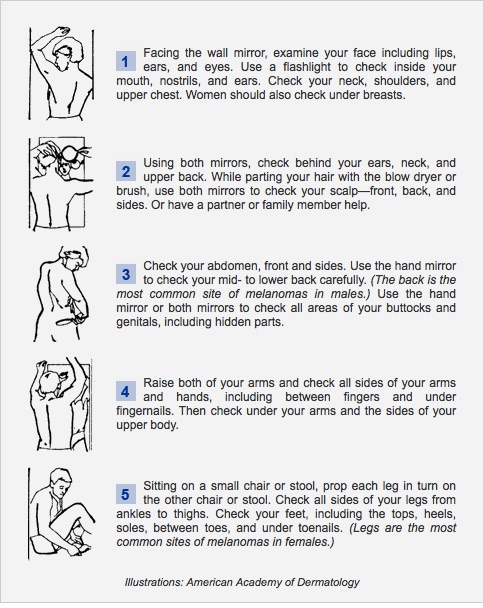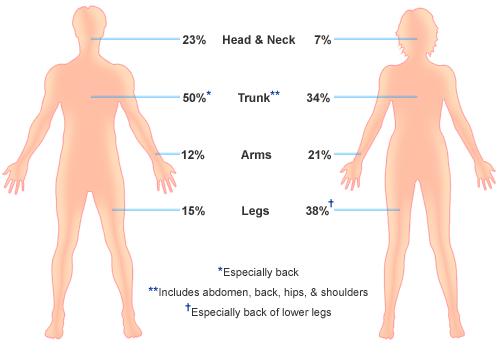March 2, 2017 | Stephen Fine, Founder and President
Self-examining for Early Signs of Melanoma
Self-examination is among the most vital weapons we all have in the fight against melanoma. There is no doubt that the more people the melanoma awareness community can reach with this message, the more lives it can save.
Why is Self-examination So Important?
As that is a fair question, we’ll give you two excellent reasons. The speed at which melanoma is discovered and treated is literally the difference between life and death. If diagnosed early enough, it can be cured quite easily. If too late, it can (and will) spread throughout the body and then painfully attack our other organs until it turns fatal.
Another fact is that patients first discover their melanomas more often than their doctors will. And of course, many of us don’t visit our physicians regularly enough to depend on them to sufficiently monitor our skin.
A Few Notes About Self-examination
The good news is that self-examination is a simple process, and takes only ten minutes or so per month. For those who may need extra motivation, please note that almost every melanoma fatality could have been prevented by early self-detection.
Furthermore, around 30% of melanomas develop onto areas of our skin that are rarely, if ever, introduced to the sun. So even if you do see your doctor on a schedule, he or she likely wouldn’t examine you in some of those areas anyway. Unless you bring it to their attention.
Performing Your Self-examination
There are two main forms of melanoma: Radial and Nodular. Nodular is the less common of the two, but it’s also deadlier. And though rare, our percentage chances of developing it are much higher in our adolescence and teenage years than they are after we reach adulthood. To learn much more about nodular melanoma, please click here.
This is how you search for radials:
On the parts of your skin that you can easily see, (arms, front/sides of legs, between fingers, toes, palms, soles, under finger and toenails) check for any new or existing moles, blemishes and marks with irregular shapes and/or dark colors. Also, note any that turn itchy and/or begin secreting fluids.
Use the combination of a full-length mirror and a hand mirror to check your back, back of legs, ears, armpits, neck and private areas. Employ a hairdryer to move your hair around as you check over your scalp.
Here are a couple of tips to make it even easier than that:
If you have a spouse, significant other or trusted friend, ask him or her to check your back and ears.
Many of us get our hair styled or cut every month or two. If this includes you, excellent. Simply ask your barber or stylist to alert you if he or she comes across any odd marks while performing their task.
For an easy access to this process, just save and print out this diagram:
Gender, Ethnicity and Melanoma
While it’s true that Caucasians and other pale-toned ethnicities are more likely to develop melanoma, it’s equally true that anyone of any age, gender or skin color can develop it, too. In fact, though it’s certainly more common in white people, once it appears it’s more often fatal to African-Americans.
Melanoma can begin anywhere on our bodies. If you’re a Caucasian man or woman, this diagram will show you the percentage breakdown of where it occurs:
If you’re Asian, Hispanic or African-American, it can be most commonly found on your hands, feet, toe and fingernails, and between the toes and fingers themselves. Indeed, legendary singer Bob Marley’s ultimately fatal Melanoma began in his toe.
Please, take just a few minutes out of each month to protect your health.


